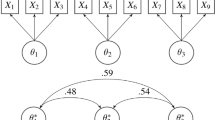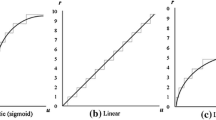Abstract
When studying quality of life, researchers have to rely on the subjective evaluations, which are typically categorized, collected in surveys. When statistical analysis are applied to these data, they used to apply the simplistic approach including (i) direct quantification, which assigns discrete numerical values to ordinal response scale, and (ii) complete-case analysis, which discards all observations selecting any of the off-scales choices like ‘Don’t Know’ ‘No Answer’ from the analysis. The present paper examines the disadvantages of this approach and introduces the ‘optimal scaling’ method as a remedy. The new scheme attempts to restore the continuity property of the measurements as well as provide estimates for most of the missing responses. Application of the new scheme to the Hong Kong QOL data illustrates how the scheme works, demonstrates its advantages and shows how the QOL indicators, the global QOL indicator as well as its inherited indicators, can be constructed from series of principal component analyses. Factor analysis of the 20 life domain indicators verifies Wan's opinion (1992) that the global sense of well-being can best be captured by two dimensions, namely the personal well-being and the societal well-being. Although previous QOL studies had seldom included perceptions towards various societal conditions to identify life satisfaction in general, our data analysis shows that satisfaction on these conditions do constitute an important component of the global QOL.
Similar content being viewed by others
REFERENCES
Andrews, F. M. and S. B. Withey: 1976, Social Indicators of Well-Being: Americans' Perceptions of Life Quality (Plenum, New York).
Campbell, A.: 1981, The Sense of Well-Being in America (McGraw Hill).
Campbell, A., P. E. Converse and W. L. Rodgers: 1976, The Quality of American Life (Russell Sage Foundation, New York).
Emil Kupek: 1997, The Use of Dimensionally Reduction Techniques in Public Health Research, Ph.D. Thesis, Imperial College School of Medicine, London University.
Evans, D. R. and W. E. Cope: 1989, Quality of Life Questionnaire Manual (Multi-Health Systems, Toronto).
Geer, J. P. van de: 1993, Multivariate Analysis of Categorical Data, Volumes 1 & 2 (Sage, Newbury Park, CA).
Headey, B., E. Holmstrom and A. Wearing: 1985, ‘Models of well-being and ill-being’ Social Indicators Research 17, pp. 211–234.
Jones, M. B. and J. M. Pierce: 1977, ‘Time-use auditing: An approach to validating social indicators’ Social Indicators Research 4, pp. 289–315.
Juster, F. T., P. N. Courant and G. K. Dow: 1981, ‘The theory and measurement of well-being: A suggested framework for accounting and analysis’ Social Accounting System: Essays on the State of Art (edited by Juster & Land, New York: Academic), pp. 23–74.
Kim, J. O. and J. Curry: 1977, ‘The treatment of missing data in multivariate analysis’ Social. Meth. Res. 6, pp. 215–240.
Kruskal, J. B.: 1964, ‘Multidimensional scaling by optimizing goodness of fit to a nonmetric hypothesis’ Psychometrika 29, pp. 1–27.
Lance, C. E., G. J. Lautenschlager, C. E. Sloan, P. E. Varca: 1989, ‘A comparison between bottom-up, top-down, and bidirectional models of relationships between global and life facet satisfaction’ Journal of Personality 57, pp. 601–624.
Little, R. J. A. and D. B. Rubin: 1987, Statistical Analysis With Missing Data (John Wiley & Sons).
McGee, H. M., C. A. O'Boyle, A. Hickey, K. O'Malley and C. R. B. Joyce: 1991, ‘Assessing the quality of life of the individual: The SEIQoL with a healthy and a gastroenterology unit population’ Psychological Medicine 21, pp. 749–759.
Mead, G. H.: 1934, Mind, Self, and Society (University of Chicago Press, Chicago).
Rice, R. W.: 1984, ‘Organizational work and the overall quality of life’ Applied Social Psychology Annual 5, pp. 155–178.
Rice, R. W., D. B. McFarlin, R. G. Hunt and J. P. Near: 1985, ‘Organizational work and the perceived quality of life: Toward a conceptual model’ Academy of Management Review 10, pp. 296–310.
Rice, R. W., M. R. Frone and D. B. McFarlin: 1992, ‘Work-nonwork conflict and the perceived quality of life’ Journal Of Organizational Behaviour 13, pp. 155–168.
Schuessler K. F. and G. A. Fisher: 1985, ‘Quality of life research and sociology’ Annual Review of Sociology 11, pp. 129–149.
Shen, S. M.: 1996, ‘An attempt to build up an index series for the quality of life in Hong Kong’ New Frontiers of Social Indicators Research (The Chinese University of Hong Kong), pp. 219–234.
Wang, Ling: 1994, Quality of Life in Urban China: A Data-based Study in the City of Tian**, Ph.D. Thesis, State University of New York at Albany.
Wan, P. S.: 1992, ‘Subjective quality of life’ Indicators of Social Development: Hong Kong 1990, (The Chinese University of Hong Kong, 1992) pp. 173–204.
Young, W. F.: 1981, ‘Quantitative analysis of qualitative data’ Psychometrika 46, pp. 357–388.
Ying, Y. W.: 1992, ‘Life satisfaction among San Francisco Chinese-Americans’ Social Indicators Research 26, pp. 1–22.
Author information
Authors and Affiliations
Rights and permissions
About this article
Cite this article
Shen, S., Lai, Y. Optimally Scaled Quality-of-Life Indicators. Social Indicators Research 44, 225–254 (1998). https://doi.org/10.1023/A:1006824827723
Issue Date:
DOI: https://doi.org/10.1023/A:1006824827723




